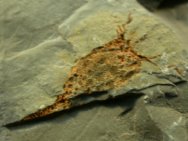| Name:
Echinodermata; Eocrinidae; Sinoeocrinus sp. (Chengjiang)
Age: Early
to Middle Cambrian
Size (25.4mm=1
inch): 25 mm long by 8 mm wide on a 50 mm by 52 mm matrix
Location:
Kaili Formation, Taijiang County, Guizhou, China
|  Description:
The Kaili Biota of Guiznou Province China, like the fantastic Chengjiang
and Burgess Shale Fauna, preserve some the of the earliest radiations
of complex life known on the planet. The formation is some 220 m
in thickness and spans the late Early to Early Middle Cambrian.
The Kaili Fauna includes both soft-bodied and skeletonized animals,
and is dominated by trilobites. There are also a number of eocrinoid
Echinoderms, with two members of the gogiid genus Sinoeocrinus predominating.
Some 3000 specimens comprising two species are known worldwide.
The Echinoderms remained a modest component of the Cambrian biota
until favorable environmental shifts allowed for a rapid radiation.
Many seem to have had no holdfast to anchor them to the substrate.
When hard substrates became more common, the eocrinoids were able
to exploit their advantage. The rapid rise of the echinoderms that
occurred during the Ordovician included the appearance of the first
true crinoids. This eocrinoid is one of the basal progenitors of
that Echinoderm radiation. The presence of Burgess Shale–like
fauna over a large part of southwestern China shows that the faunal
community was quite cosmopolitan in nature, indicating that preservation
was more of a factor in finding these concentrations of animals
than was the existence of isolated communities suitable for harboring
these myriad life forms. Description:
The Kaili Biota of Guiznou Province China, like the fantastic Chengjiang
and Burgess Shale Fauna, preserve some the of the earliest radiations
of complex life known on the planet. The formation is some 220 m
in thickness and spans the late Early to Early Middle Cambrian.
The Kaili Fauna includes both soft-bodied and skeletonized animals,
and is dominated by trilobites. There are also a number of eocrinoid
Echinoderms, with two members of the gogiid genus Sinoeocrinus predominating.
Some 3000 specimens comprising two species are known worldwide.
The Echinoderms remained a modest component of the Cambrian biota
until favorable environmental shifts allowed for a rapid radiation.
Many seem to have had no holdfast to anchor them to the substrate.
When hard substrates became more common, the eocrinoids were able
to exploit their advantage. The rapid rise of the echinoderms that
occurred during the Ordovician included the appearance of the first
true crinoids. This eocrinoid is one of the basal progenitors of
that Echinoderm radiation. The presence of Burgess Shale–like
fauna over a large part of southwestern China shows that the faunal
community was quite cosmopolitan in nature, indicating that preservation
was more of a factor in finding these concentrations of animals
than was the existence of isolated communities suitable for harboring
these myriad life forms.
|
|